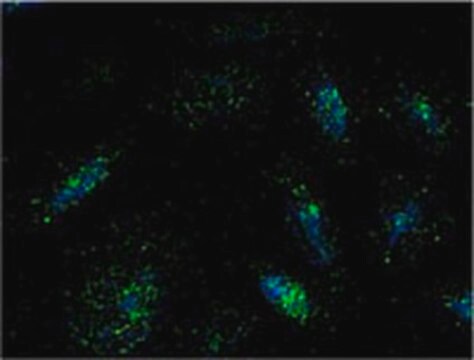推薦產品
生物源
rabbit
共軛
CY3 conjugate
抗體表格
affinity isolated antibody
抗體產品種類
primary antibodies
無性繁殖
polyclonal
形狀
buffered aqueous solution
物種活性
mouse, human, rat
濃度
1-2 mg/mL
技術
direct immunofluorescence: 1-2 μg/mL using human HeLa cells, rat NRK cells and mouse 3T3 cells
UniProt登錄號
運輸包裝
wet ice
儲存溫度
2-8°C
目標翻譯後修改
unmodified
基因資訊
human ... LAMP1(3916)
mouse ... Lamp1(16783)
rat ... Lamp1(25328)
一般說明
Lysosomal-associated membrane protein 1 (LAMP1), also termed LGP120, is a heavily glycosylated lysosomal membrane protein with a molecular mass of 120 kDa. It consists of a 40 kDa core polypeptide with O-linked and 18 asparagine-linked oligosaccharide side chains. LAMP1 protein contains a leader sequence, a large intralumenal region consisting of 2 homologous domains separated by a hinge region rich in proline and serine, a 24-amino acid transmembrane region, and a short cytoplasmic tail containing the lysosomal membrane targeting signal.
The gene LAMP1 (lysosomal-associated membrane protein 1) encodes a type I transmembrane protein that has a short cytoplasmic tail containing a lysosome-targeting signal of GYQTI(382)-COOH. The gene is mapped to human chromosome 13q34.
應用
Anti-LAMP1-Cy3™ antibody produced in rabbit has been used in immunofluorescence.
生化/生理作用
The gene LAMP1 (lysosomal associated membrane protein 1) encodes a membrane glycoprotein that functions as an intracellular receptor. It is found to be expressed in the cytoplasm of several types of tumor cells and may be involved in tumor invasion. Lamp1 is crucial for perforin trafficking to the lytic granules and motility of these lytic granules. Its knockdown leads to inhibition of cytotoxicity of human natural killer cells.
外觀
Solution in 0.01 M phosphate buffered saline, pH 7.4, containing 15 mM sodium azide.
法律資訊
Cy3 is a trademark of Cytiva
免責聲明
Unless otherwise stated in our catalog or other company documentation accompanying the product(s), our products are intended for research use only and are not to be used for any other purpose, which includes but is not limited to, unauthorized commercial uses, in vitro diagnostic uses, ex vivo or in vivo therapeutic uses or any type of consumption or application to humans or animals.
未找到適合的產品?
試用我們的產品選擇工具.
儲存類別代碼
12 - Non Combustible Liquids
水污染物質分類(WGK)
WGK 2
閃點(°F)
Not applicable
閃點(°C)
Not applicable
個人防護裝備
Eyeshields, Gloves, multi-purpose combination respirator cartridge (US)
分析證明 (COA)
輸入產品批次/批號來搜索 分析證明 (COA)。在產品’s標籤上找到批次和批號,寫有 ‘Lot’或‘Batch’.。
Expression of the lysosomal-associated membrane protein-1 (LAMP-1) in astrocytomas
Jensen SS, et al.
International Journal of Clinical and Experimental Pathology, 6(7), 1294-1294 (2013)
Shou-Bin Tang et al.
Reproduction (Cambridge, England) (2019-03-19)
It is demonstrated that repeated superovulation has deleterious effects on mouse ovaries and cumulus cells. However, little is known about the effects of repeated superovulation on early embryos. Epigenetic reprogramming is an important event in early embryonic development, and could
Three-dimensional invasion of macrophages is mediated by cysteine cathepsins in protrusive podosomes.
Jevnikar Z, et.al.
European Journal of Immunology, 42, 3429-3441 (2012)
Zala Jevnikar et al.
European journal of immunology, 42(12), 3429-3441 (2012-09-29)
Podosomes, specialized actin-rich structures in macrophages (Mfs), degrade the extra-cellular matrix (ECM) and are involved in cell migration. On two-dimensional (2D) surfaces Mfs form spot-like podosomes at the ventral cell surface that develop into protrusive structures in a three-dimensional (3D)
C Banfi et al.
Communications biology, 4(1), 1109-1109 (2021-09-23)
The research into the pathophysiology of atherosclerosis has considerably increased our understanding of the disease complexity, but still many questions remain unanswered, both mechanistically and pharmacologically. Here, we provided evidence that the pro-oxidant enzyme Prenylcysteine Oxidase 1 (PCYOX1), in the
我們的科學家團隊在所有研究領域都有豐富的經驗,包括生命科學、材料科學、化學合成、色譜、分析等.
聯絡技術服務






